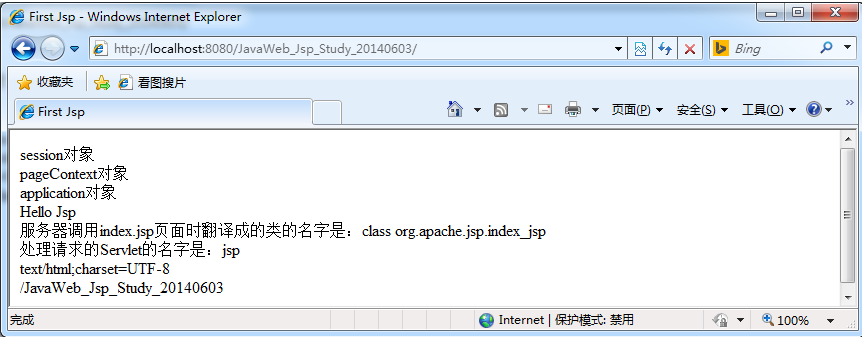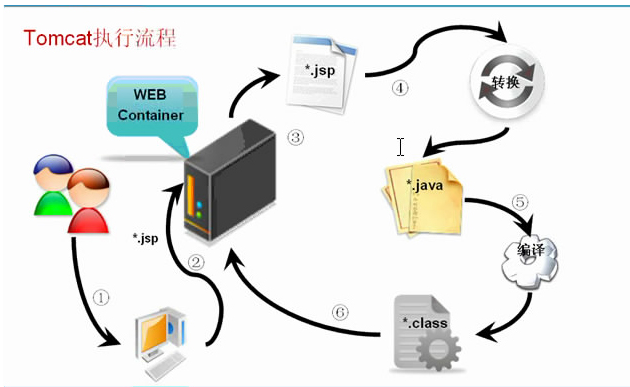一、什么是JSP
JSP全称是Java Server Pages,它和servle技术一样,都是SUN公司定义的一种用于开发动态web资源的技术。
JSP这门技术的最大特点在于,写JSP就行html,但是html只能提供静态数据,而Jsp技术可以嵌套Java代码,为用户提供动态数据。
二、JSP原理
1、Web服务器是如何调用并执行一个jsp页面的?
浏览器向服务器发请求,不管访问的是什么资源,其实都是在访问Servlet,所以当访问一个jsp页面时,其实也是在访问一个Servlet,服务器在执行jsp的时候,首先把jsp翻译成一个Servlet,所以我们访问jsp时,其实不是在访问jsp,而是在访问jsp翻译过后的那个Servlet,例如下面的代码:
index.jsp
<%@ page language="java" import="java.util.*" pageEncoding="UTF-8"%> <% String path = request.getContextPath(); String basePath = request.getScheme()+"://"+request.getServerName()+":"+request.getServerPort()+path+"/"; %> <!DOCTYPE HTML PUBLIC "-//W3C//DTD HTML 4.01 Transitional//EN"> <html> <head> <base href="<%=basePath%>"> <title>First Jsp</title> </head> <body> <% out.print("Hello Jsp"); %> </body> </html>
当我们通过浏览器访问index.jsp时,服务器首先将index.jsp翻译成一个index_jsp.class,在Tomcat服务器的workCatalinalocalhost项目名orgapachejsp目录下可以看到index_jsp.class的源代码文件index_jsp.java,index_jsp.java的代码如下:
package org.apache.jsp; import javax.servlet.*; import javax.servlet.http.*; import javax.servlet.jsp.*; import java.util.*; public final class index_jsp extends org.apache.jasper.runtime.HttpJspBase implements org.apache.jasper.runtime.JspSourceDependent { private static final JspFactory _jspxFactory = JspFactory.getDefaultFactory(); private static java.util.List _jspx_dependants; private javax.el.ExpressionFactory _el_expressionfactory; private org.apache.AnnotationProcessor _jsp_annotationprocessor; public Object getDependants() { return _jspx_dependants; } public void _jspInit() { _el_expressionfactory = _jspxFactory.getJspApplicationContext(getServletConfig().getServletContext()).getExpressionFactory(); _jsp_annotationprocessor = (org.apache.AnnotationProcessor) getServletConfig().getServletContext().getAttribute(org.apache.AnnotationProcessor.class.getName()); } public void _jspDestroy() { } public void _jspService(HttpServletRequest request, HttpServletResponse response) throws java.io.IOException, ServletException { PageContext pageContext = null; HttpSession session = null; ServletContext application = null; ServletConfig config = null; JspWriter out = null; Object page = this; JspWriter _jspx_out = null; PageContext _jspx_page_context = null; try { response.setContentType("text/html;charset=UTF-8"); pageContext = _jspxFactory.getPageContext(this, request, response, null, true, 8192, true); _jspx_page_context = pageContext; application = pageContext.getServletContext(); config = pageContext.getServletConfig(); session = pageContext.getSession(); out = pageContext.getOut(); _jspx_out = out; out.write(' '); out.write(' '); String path = request.getContextPath(); String basePath = request.getScheme()+"://"+request.getServerName()+":"+request.getServerPort()+path+"/"; out.write(" "); out.write(" "); out.write("<!DOCTYPE HTML PUBLIC "-//W3C//DTD HTML 4.01 Transitional//EN"> "); out.write("<html> "); out.write(" <head> "); out.write(" <base href=""); out.print(basePath); out.write(""> "); out.write(" "); out.write(" <title>First Jsp</title> "); out.write(" "); out.write(" </head> "); out.write(" "); out.write(" <body> "); out.write(" "); out.print("Hello Jsp"); out.write(" "); out.write(" </body> "); out.write("</html> "); } catch (Throwable t) { if (!(t instanceof SkipPageException)){ out = _jspx_out; if (out != null && out.getBufferSize() != 0) try { out.clearBuffer(); } catch (java.io.IOException e) {} if (_jspx_page_context != null) _jspx_page_context.handlePageException(t); } } finally { _jspxFactory.releasePageContext(_jspx_page_context); } } }
HttpJsBase这个类的源代码,HttpJspBase类是继承HttpServlet的,所以HttpJspBase类是一个Servlet,而index_jsp又是继承HttpJspBase类的,所以index_jsp类也是一个Servlet,所以当浏览器访问服务器上的index.jsp页面时,其实就是在访问index_jsp这个Servlet,index_jsp这个Servlet使用_jspService这个方法处理请求。
2、Jsp页面中的html排版标签是如何被发送到客户端的?
浏览器接收到的这些数据
<!DOCTYPE HTML PUBLIC "-//W3C//DTD HTML 4.01 Transitional//EN">
<html>
<head>
<base href="http://localhost:8080/JavaWeb_Jsp_Study_20140603/">
<title>First Jsp</title>
</head>
<body>
Hello Jsp
</body>
</html>
都是在_jspService方法中使用如下的代码输出给浏览器的:
out.write('
');
out.write('
');
String path = request.getContextPath();
String basePath = request.getScheme()+"://"+request.getServerName()+":"+request.getServerPort()+path+"/";
out.write("
");
out.write("
");
out.write("<!DOCTYPE HTML PUBLIC "-//W3C//DTD HTML 4.01 Transitional//EN">
");
out.write("<html>
");
out.write(" <head>
");
out.write(" <base href="");
out.print(basePath);
out.write("">
");
out.write("
");
out.write(" <title>First Jsp</title>
");
out.write("
");
out.write(" </head>
");
out.write("
");
out.write(" <body>
");
out.write(" ");
out.print("Hello Jsp");
out.write("
");
out.write(" </body>
");
out.write("</html>
");
在jsp中编写的java代码和html代码都会被翻译到_jspService方法中去,在jsp中编写的java代码会原封不动地翻译成java代码,如<%out.print("Hello Jsp");%>直接翻译成out.print("Hello Jsp");,而HTML代码则会翻译成使用out.write("<html标签> ");的形式输出到浏览器。在jsp页面中编写的html排版标签都是以out.write("<html标签> ");的形式输出到浏览器,浏览器拿到html代码后才能够解析执行html代码。
3、Jsp页面中的java代码服务器是如何执行的?
在jsp中编写的java代码会被翻译到_jspService方法中去,当执行_jspService方法处理请求时,就会执行在jsp编写的java代码了,所以Jsp页面中的java代码服务器是通过调用_jspService方法处理请求时执行的。
4、Web服务器在调用jsp时,会给jsp提供一些什么java对象?
查看_jspService方法可以看到,Web服务器在调用jsp时,会给Jsp提供如下的8个java对象
PageContext pageContext; HttpSession session; ServletContext application; ServletConfig config; JspWriter out; Object page = this; HttpServletRequest request, HttpServletResponse response
其中page对象,request和response已经完成了实例化,而其它5个没有实例化的对象通过下面的方式实例化
pageContext = _jspxFactory.getPageContext(this, request, response,null, true, 8192, true); application = pageContext.getServletContext(); config = pageContext.getServletConfig(); session = pageContext.getSession(); out = pageContext.getOut();
这8个java对象在Jsp页面中是可以直接使用的,如下所示:
<% session.setAttribute("name", "session对象");//使用session对象,设置session对象的属性 out.print(session.getAttribute("name")+"<br/>");//获取session对象的属性 pageContext.setAttribute("name", "pageContext对象");//使用pageContext对象,设置pageContext对象的属性 out.print(pageContext.getAttribute("name")+"<br/>");//获取pageContext对象的属性 application.setAttribute("name", "application对象");//使用application对象,设置application对象的属性 out.print(application.getAttribute("name")+"<br/>");//获取application对象的属性 out.print("Hello Jsp"+"<br/>");//使用out对象 out.print("服务器调用index.jsp页面时翻译成的类的名字是:"+page.getClass()+"<br/>");//使用page对象 out.print("处理请求的Servlet的名字是:"+config.getServletName()+"<br/>");//使用config对象 out.print(response.getContentType()+"<br/>");//使用response对象 out.print(request.getContextPath()+"<br/>");//使用request对象 %>
运行结果如下:

5、Jsp最佳实践
Jsp最佳实践就是jsp技术在开发中该怎么去用。
不管是JSP还是Servlet,虽然都可以用于开发动态web资源。但由于这2门技术各自的特点,在长期的软件实践中,人们逐渐把servlet作为web应用中的控制器组件来使用,而把JSP技术作为数据显示模板来使用。其原因为,程序的数据通常要美化后再输出:让jsp既用java代码产生动态数据,又做美化会导致页面难以维护。让servlet既产生数据,又在里面嵌套html代码美化数据,同样也会导致程序可读性差,难以维护。因此最好的办法就是根据这两门技术的特点,让它们各自负责各的,servlet只负责响应请求产生数据,并把数据通过转发技术带给jsp,数据的显示jsp来做。
6、Tomcat服务器的执行流程

第一次执行:
- 客户端通过电脑连接服务器,因为是请求是动态的,所以所有的请求交给WEB容器来处理
- 在容器中找到需要执行的*.jsp文件
- 之后*.jsp文件通过转换变为*.java文件
- *.java文件经过编译后,形成*.class文件
- 最终服务器要执行形成的*.class文件
第二次执行:
- 因为已经存在了*.class文件,所以不在需要转换和编译的过程
修改后执行:
1.源文件已经被修改过了,所以需要重新转换,重新编译。